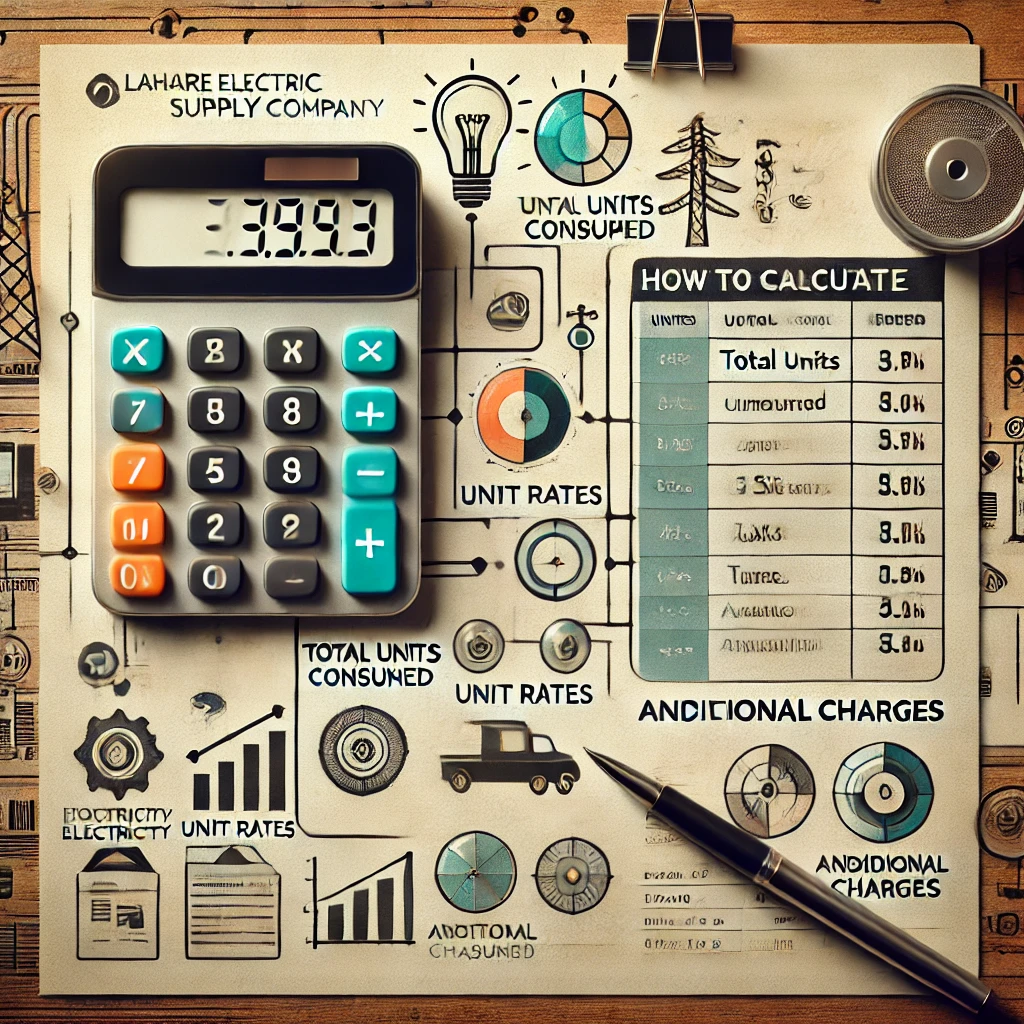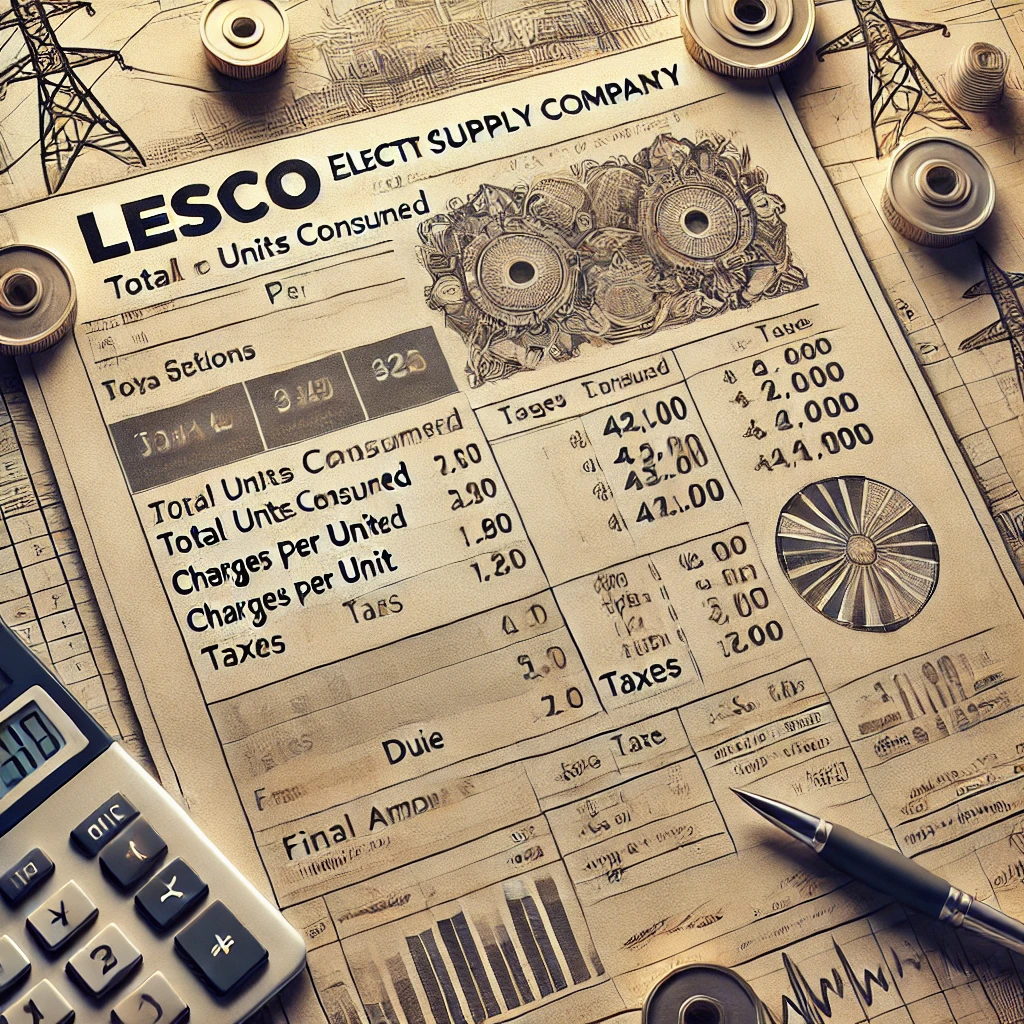If you’ve ever looked at your Lahore Electric Supply Company (LESCO) bill and wondered what all those numbers and terms mean, you’re not alone. Electricity bills can be confusing, especially if you don’t understand the charges, meter readings, or tariffs. But don’t worry, in this blog, I’m going to break down everything you need to know about your LESCO bill in simple, easy-to-understand language.
What is LESCO?
LESCO stands for Lahore Electric Supply Company, one of the largest electric supply companies in Pakistan. LESCO provides electricity to the districts of Lahore, Kasur, Sheikhupura, and Okara. It’s a state-owned company that delivers electricity to millions of homes, industries, and businesses in these areas.
Key Sections of Your LESCO Bill
When you look at your LESCO bill, you’ll see a lot of information, from meter readings to tariffs and taxes. To make sense of it all, let’s break it down into the main sections.
1. Consumer Information
At the top of your bill, you’ll find your consumer details, including:
Name of the Consumer: This is the name under which the bill is registered.
Consumer Number: Your unique identifier in LESCO’s system. This number is essential for bill inquiries, complaints, and payments.
Meter Number: Every electric meter has its unique number, and this number helps LESCO track your usage.
Tariff: This shows the category under which your connection falls. Tariffs vary for residential, commercial, industrial, and agricultural users.
2. Meter Reading and Consumption Details
This section contains your meter readings and electricity consumption details:
Previous Reading: The reading from the last billing period.
Current Reading: The reading at the end of the current billing period.
Units Consumed: The difference between the current and previous readings, showing how many units (kilowatt-hours or kWh) you used during the billing cycle.
3. Billing Date and Due Date
Your bill will also mention:
Bill Issuance Date: The date your bill was generated.
Due Date: The last date to pay your bill without any late payment charges. Be sure to pay by this date to avoid penalties.
4. Billing Amount
This is the part most people focus on — how much do you owe?
Energy Charges: These are the basic charges for the units of electricity you consumed.
Fixed Charges: Some tariffs include fixed charges that you pay irrespective of your consumption.
Fuel Price Adjustment (FPA): This is an additional charge that varies based on fuel prices used for electricity generation.
Taxes and Levies: The government imposes various taxes, such as GST (General Sales Tax), Income Tax, and TV fees.
Late Payment Surcharge: If you didn’t pay your previous bill on time, a late payment surcharge will be added.
Total Payable: This is the final amount you need to pay, including all charges, taxes, and surcharges.
Understanding Your Tariff
LESCO operates under a variety of tariff categories. Residential tariffs are different from commercial and industrial ones. Here’s a brief explanation:
Residential (A-1): This is the category for homes. There are different slabs depending on your monthly usage. For example, if you use under 50 units, your rate per unit will be lower compared to someone using over 500 units per month.
Commercial (A-2): This is for shops, offices, and other small businesses. The rate per unit is generally higher than residential tariffs.
Industrial (B): Industries consume large amounts of electricity, so they have a different tariff structure.
Agricultural (C): Farmers using electricity for irrigation purposes fall under this category and have lower rates.
Special Tariff (D): This applies to places like hospitals, universities, and government institutions.
How to Calculate Your LESCO Bill

Want to calculate your LESCO bill before it arrives? Here’s a simple way to do it.
1. Check Your Tariff Rate: LESCO publishes its tariff rates on its website, or you can find them on your previous bill.
2. Find the Number of Units Consumed: Look at your meter and subtract the previous reading from the current reading.
3. Multiply Units by Tariff Rate: Multiply the units consumed by the rate per unit in your tariff slab.
4. Add Fixed Charges and Taxes: Add any fixed charges and taxes (like GST) to get the total amount payable.
For example, if you are a residential consumer and used 300 units, you would multiply those units by the rate in your slab and then add taxes and any other charges.
What is Fuel Price Adjustment (FPA)?
Fuel Price Adjustment (FPA) is an additional charge that reflects changes in fuel costs. Since a large portion of electricity in Pakistan is generated using fuel like oil and gas, fluctuations in international fuel prices directly affect the cost of electricity. If fuel prices rise, your electricity bill will include an FPA charge to compensate for that increase. Conversely, if fuel prices drop, you might see a lower FPA on your bill.
Common Queries and FAQs about LESCO Bill
1. How can I check my LESCO bill online?
You can easily check your LESCO bill online by visiting the official LESCO website or using the LESCO bill-checking apps available on mobile. All you need is your consumer number, which you can find on your previous bill.
2. What happens if I don’t pay my bill by the due date?
If you don’t pay your LESCO bill by the due date, you will incur a late payment surcharge. Continued non-payment can result in disconnection of your electricity supply, and you’ll have to pay additional charges to get it reconnected.
3. How can I reduce my LESCO bill?
Here are some tips to reduce your electricity consumption:
Use energy-efficient appliances: Switching to energy-efficient bulbs, fans, and air conditioners can reduce your energy consumption significantly.
Turn off appliances when not in use: Even appliances in standby mode consume electricity.
Install solar panels: Many households are now using solar panels to generate their own electricity, reducing dependence on the grid.
4. Why is my bill so high?
There can be several reasons for a high LESCO bill:
Increased consumption: Check your usage habits. Are you using air conditioning or heating more than usual?
Fuel price adjustment: If fuel prices have increased, it will reflect in your bill.
Faulty meter: If you suspect your meter is faulty, you can request LESCO to inspect it.
5. What should I do if my meter reading is incorrect?
If you believe the meter reading on your bill is incorrect, contact LESCO customer service or visit your nearest LESCO office to lodge a complaint. They will inspect the meter and correct the bill if there’s a mistake.
How to Pay Your LESCO Bill
Paying your LESCO bill has become very convenient, with multiple payment options available:
Banks: You can pay your bill at any major bank branch.
Online Banking: Many banks offer online bill payment services.
Mobile Apps: Use apps like JazzCash, EasyPaisa, or your bank’s app to pay the bill from your phone.
LESCO Offices: You can visit LESCO offices for payments as well.
ATMs: Many ATMs offer bill payment options as well.
How to Lodge a Complaint with LESCO
If you face any issues with your electricity supply or billing, LESCO has a complaints procedure you can follow. Here’s how you can lodge a complaint:
1. Visit the LESCO website: They have an online complaints section where you can submit your issue.
2. Call the LESCO helpline: You can also call their 24/7 helpline to speak to a customer representative.
3. Visit a LESCO office: If your issue isn’t resolved online or via phone, visiting your local LESCO office can help.
Conclusion
Your LESCO bill might seem complicated at first, but understanding the breakdown of charges and how to calculate your consumption can make managing your electricity usage much easier. By keeping track of your meter readings, tariff rates, and taxes, you can avoid surprises when your bill arrives and take steps to reduce your consumption to save on electricity costs.
Got more questions? Leave them in the comments below, and I’ll help you figure it out!


1 thought on “Understanding Your LESCO Bill: A Complete Guide”